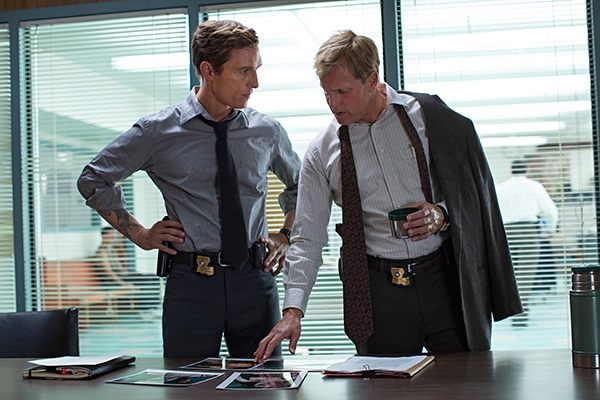“You know the job. You’re looking for narrative.” – Det. Martin Hart
Narrative seems to be one of the last things on the minds of True Detective creator Nic Pizzolatto and director Cary Fukunaga during the second episode, “Seeing Things”. Indeed, the ritualistic murders being investigated by Det. Martin Hart and Det. Rust Cohle seems decidedly secondary in comparison to the real mystery of the show – what lurks within the two men. ‘I’m the police. I can do terrible things to people. With impunity.’, Cohle drawls at a frightened call girl. Are the two central characters in True Detective are edging toward a darkness too overwhelming to control?
How the information is revealed to us is crucial in our understanding of these men. For instance, in “Seeing Things”, Cohle reveals to Hart that his daughter died, something he had already shared with both Hart’s wife Maggie and the audience in the previous episode. He doesn’t divulge to his partner the fact that he spent four months in a psychiatric hospital as a result of emptying his gun into a man who was abusing his own daughter, which is revealed to the audience during the 2012 interviews. The multiple timelines mean that certain information offered to us has dramatically increased significance. Certain details of both men that we know as a result of the 2012 interviews may have monumental consequences. We know that someone was put in jail for the 1995 murders, perhaps wrongfully. And it seems that Cohle is a suspect in the more recent murders. One of the most exciting elements of True Detective is that it gives the audience more clues than the characters thanks to the power of hindsight.

There is still a lot in “Seeing Things” that falls surprisingly flat for a show that gets so much right. The plot itself is unremarkable to the point of being amazing, particularly in regard to the procedural elements. We’ve seen it all before, in dozen of cop shows that have preceded True Detective. Hart and Cohle are even given a ’24 hours to crack the case, McGonagall’ deadline by their superiors. Hart’s relationship with his wife also wavered dangerously into Carmella Soprano/Skyler White territory. It would be unfortunate if a show with such commanding central characters would relegate the leading female into the role of ‘complaining wife.’
As in the initial episode “The Long Bright Dark”, the most compelling aspect of “Seeing Things” is the central performances by Woody Harrelson and Matthew McConaughey. Harrelson as Hart no longer appears to be the steady, reliable guy he initially seemed. He’s carrying on with a younger woman (something Cohle is quick to sniff out) and his relationship with his wife is less stable than perhaps even he’d like to believe. Cohle on the other hand, is revealed to suffer from hallucinations as a result from his time in the drug squad. The hallucination sequences enhance the fantastical element of the show, which has so far maintained a nice level of subtlety. It would be unfortunate if True Detective veered too far into the supernatural.
A lot seems to be pointing toward Cohle being the killer, not least the interest the questioning police in 2012 have in his methods, but it’s highly unlikely anything could be so simple in a show of this calibre. There are too many things pointing towards Cohle having inside knowledge of the case, such as his correct guess that the victim was a prostitute or his ease in finding the devil net toward the end of “The Long Bright Dark” that it’s more likely Pizzolatto wants us to be wary of McConaughey’s character. It would be a rare thing in such a genre that the immediately obvious suspect turns out to be the perpetrator.
For more on Television, click here. If you’re digging ReelGood, sign up to our mailing list for exclusive content, early reviews and chances to win big!